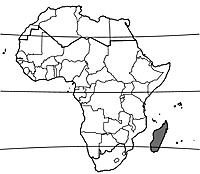Bauhinia podopetala (PROTA)
Introduction |
| General importance | |
| Geographic coverage Africa | |
| Geographic coverage World | |
| Timber | |
| Fuel | |
| Conservation status | |
Bauhinia podopetala Baker
- Protologue: Journ. Linn. Soc., Bot. 25: 313 (1890).
- Family: Caesalpiniaceae (Leguminosae - Caesalpinioideae)
Origin and geographic distribution
Bauhinia podopetala is endemic to northern and western Madagascar, from Antsiranana in the north, south to Morondava.
Uses
The wood is used for house construction, especially for poles, and for fences. It is suitable for joinery, interior trim, boxes and crates. It is also used as firewood.
Properties
The wood of Bauhinia spp. from Madagascar is medium-weight, with a density of about 680 kg/m³ at 12% moisture content, and moderately hard. It is easy to dry with moderate shrinkage rates. It is fairly stable in service. It is easy to work and not durable, but moderately easy to treat with preservatives.
Description
- Deciduous shrub or small tree up to 15 m tall; bole up to 20 cm in diameter; bark surface smooth and reddish brown, slightly peeling; twigs glabrous, with lenticels.
- Leaves alternate, simple; stipules triangular, c. 2 mm long; petiole slender, (1.5–)2–4(–4.5) cm long; blade 2-lobed to about the middle, 5.5–9.5(–12) cm × 5–9(–12) cm, truncate to rounded at base, lobes acute to acuminate at apex, nearly glabrous, 7(–9)-veined from the base.
- Inflorescence a terminal raceme 2–7 cm long, often branched and panicle-like, many-flowered, the flowers opening sequentially.
- Flowers bisexual, zygomorphic, 5-merous; pedicel 0.5–1.5 cm long; calyx spathe-like, 3.5–4.5 cm long, with beak or teeth at apex, glabrous; petals free, 5–8 cm long, with long greenish claw and ovate to elliptical, pale salmon-pink blade, upper petal slightly longer and narrower than other ones and with a large pale yellow blotch at base; stamens 5, 4–7 cm long, staminodes 5, 1–2 cm long; ovary superior, elongated, c. 1.5 cm long, glabrous, style c. 2.5 cm long, with head-shaped stigma.
- Fruit a linear-oblong, flattened pod 20–25 cm long, with stipe c. 2 cm long at base and beaked at apex, glabrous, dehiscent with 2 valves, 10–20-seeded.
- Seeds disk-shaped to oblong, 10–11 mm long, blackish brown.
Other botanical information
Bauhinia is a widespread tropical genus with 150–250 species, depending on the demarcation of the genus. It is well known for its ornamental shrubs and trees, planted in parks and gardens, and as roadside tree. In Madagascar about 15 species are found, all but one endemic. The wood of some of these is used for similar purposes as that of Bauhinia podopetala.
Bauhinia grandidieri
Bauhinia grandidieri Baill. is a shrub up to 3 m tall, occurring in dry woodland and scrubland in southern Madagascar. The stems are used as poles in house construction, and as firewood. Plants of Bauhinia grandidieri with their lilac-blue to whitish flowers are occasionally traded as ornamental, also as bonsai tree.
Bauhinia hildebrandtii
Bauhinia hildebrandtii Vatke is a shrub or small tree up to 10 m tall, with bole up to 30 cm in diameter, found in more humid deciduous woodland in northern and north-western Madagascar, and also in Comoros. The bole and branches are used as posts and poles in house construction, and for fences and cattle enclosures.
Bauhinia madagascariensis
Bauhinia madagascariensis Desv. is a shrub or small tree up to 6(–10) m tall from south-western and southern Madagascar, occurring in more humid to dry deciduous woodland and scrubland. Its stems are used as posts in house construction, whereas the bark is used as rope. Seeds are occasionally offered for sale, to grow the plants with their reddish flowers.
Bauhinia morondavensis
Bauhinia morondavensis Du Puy & R.Rabev. is a shrub or small tree up to 7 m tall, also occurring in deciduous woodland and scrubland in south-western and southern Madagascar. Its stems are used as poles in house construction and as firewood; the bark is used as rope.
Ecology
Bauhinia podopetala occurs in deciduous woodland, often along rivers or in valleys, up to 300 m altitude. It is found on sandy and alluvial soils.
Genetic resources
Bauhinia podopetala is quite widespread in Madagascar and does not seem to be liable to genetic erosion at present.
Prospects
Bauhinia podopetala and other Bauhinia spp. from Madagascar do not have prospects as commercial timber trees because their boles are too small and too poorly shaped. They will remain of limited importance for local house building and for firewood production as long as they occur in sufficient quantities. With their often large and conspicuous flowers, they may be interesting ornamental shrubs and trees like several other Bauhinia spp., but research is needed on propagation and planting.
Major references
- du Puy, D.J., Labat, J.N., Rabevohitra, R., Villiers, J.-F., Bosser, J. & Moat, J., 2002. The Leguminosae of Madagascar. Royal Botanic Gardens, Kew, Richmond, United Kingdom. 750 pp.
- Rakotovao, G., Rabevohitra, R., Gerard, J., Détienne, P. & Collas de Chatelperron, P., en préparation. Atlas des bois de Madagascar. FOFIFA-DRFP, Antananarivo, Madagascar.
- Schatz, G.E., 2001. Generic tree flora of Madagascar. Royal Botanic Gardens, Kew, Richmond, United Kingdom. 477 pp.
Other references
- Lewis, G., Schrire, B., MacKinder, B. & Lock, M., 2005. Legumes of the world. Royal Botanic Gardens, Kew, Richmond, United Kingdom. 577 pp.
Author(s)
- R.H.M.J. Lemmens, PROTA Network Office Europe, Wageningen University, P.O. Box 341, 6700 AH Wageningen, Netherlands
Correct citation of this article
Lemmens, R.H.M.J., 2010. Bauhinia podopetala Baker. [Internet] Record from PROTA4U. Lemmens, R.H.M.J., Louppe, D. & Oteng-Amoako, A.A. (Editors). PROTA (Plant Resources of Tropical Africa / Ressources végétales de l’Afrique tropicale), Wageningen, Netherlands. <http://www.prota4u.org/search.asp>.
Accessed 2 June 2025.
- See the Prota4U database.


